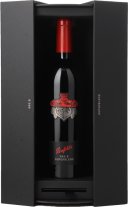Guigal Cote-Rotie 'La Turque'
Château Palmer
Château Ducru-Beaucaillou St-Julien
Reputed to be the leading star of the ''Super Seconds'' of Bordeuax, Chateau Ducru-Beaucaillou is set over 50 hectares of vineyards in the south of St-Julien. The wine is composed from predominately Cabernet Sauvignon and Merlot, with lesser influence from Cabernet Franc and Petit Verdot and spends around 18 months in half new and half seasoned oak barriques. The 2010 vintage has conspired to produce what could arguably called one of the greatest releases of this wine, resplendent with fine, firm tannin, subtle oak, quiet power and a capacity to cellar for another half century.
Chris Ringland Dry Grown Barossa Ranges Shiraz
Chris Ringland's Barossa Ranges Shiraz is steeped in the Barossas post-colonial story and the high art and science of winemaking. Typically deep in colour with intense dark berry, paneforte, espresso roasted chestnut aromas, it displays a plush and concentrated palate with blackberry, mocha, paneforte spicy flavours and dense fine chocolaty tannins. Despite the opulence, flamboyance, richness and concentration, the wine has superb percussion and freshness. The wine is a small vinification of around four to five hogsheads or 1500 litres. The "unusually thick skinned" Shiraz is entirely sourced from Chris Ringland's dry-grown vineyard on the edge of the Barossa Valley, but technically in Eden Valley, along Flaxman's Valley near Randall's Hill. The wine is "painstakingly hand-made" in open fermenters and regularly pumped-over to extract colour, flavour and tannins. After draining and pressing through a traditional basket press, fermentation is completed in 100% new French oak hogsheads. A period of up to 50 months oak maturation follows to achieve optimum complexity and balance between oak and fruit. The extraordinarily high release prices (higher than Penfolds Grange), limited production and reputation make Chris Ringland Barossa Ranges Shiraz the stuff of legend.
Penfolds Superblend 802.B Cabernet Shiraz
PENFOLDS Superblend 802.B Cabernet Shiraz, South Australia 2018 Australias most lauded winery has amalgamated their classic varietals for the coveted 2018 blend, sourcing fruit from Barossa Valley, McLaren Vale, Coonawarra, Wrattonbully, Robe and Clare Valley. An impressive example of Cabernet Shiraz, the 802.B reflects the revered red labels curiosity, innovation and vision for producing elevated Australian wines. Time and time again. A blend of 55% Cabernet Sauvignon and 45% Shiraz blended after fermentation, then matured for 19 months in French oak hogsheads. The 2018 displays complex aromas of dark spiced fruit, graphite, soy, and chocolate with a hint of cedary oak. The palate is layered and sleek with pure and intense fruit flavours, and tannins that are mineral and fine. Medium to full-bodied, silky and delicate, with a long, lingering finish, the 802.B is a true collector's dream.
Paul Jaboulet Aine La Chapelle
Chateau Pavie
Another terrific success for the flagship estate (a 92-acre vineyard situated on the famed limestone and clay-rich slopes of Cote Pavie) of Chantal and Gerard Perse, the 2011 Pavie is composed of 70% Merlot, 20% Cabernet Franc and 10% Cabernet Sauvignon. 2011 may be the biggest, richest, most massive wine of the vintage. With thrilling levels of concentration, tremendous purity, high but sweet tannin, a skyscraper-like mouthfeel, and terrific intensity, depth and palate presence, this larger-than-life effort will require 5-8 years of cellaring, and should age effortlessly over the following 25-30 years.
Penfolds 802.A Superblend
Pende Valde_The Mosman_Shiraz_Barossa Valley_Marananga_750ml
Embark on a journey of red wine excellence with The Mosman, a remarkable tribute to the enduring legacy of Archibald Mosman (1799-1863), a visionary Scottish merchant and pastoralist. Like the man himself, this wine is a testament to his pursuit of perfection and entrepreneurial spirit. Just as Archibald Mosman transformed Sydney with his thriving business, The Mosman wine sets a new standard of excellence in the world of wines. Capturing the essence of this visionary figure, The Mosman boasts a dark mahogany red hue that echoes his bold and daring approach to life. Its nose is a symphony of aromas, densely concentrated with notes of sweet coconut oak, molasses, and dehydrated plums. This aromatic experience is a testament to the wine's youthful vitality and the rich journey it offers to all who partake. This red wine is an experience of contrasts, much like Archibald Mosman's journey. Its palate delivers a chunky, velvety, and warm mouthfeel that envelopes the senses in a wild ride of concentrated flavors. The alcohol warmth, reminiscent of the passion that fueled Mosman's ambitions, adds to the wine's overall appeal, creating a harmonious balance that lingers on the palate. A testament to longevity, The Mosman is approachable now yet promises to mature gracefully over the next decade, echoing Archibald Mosman's lasting influence. As he thrived in various ventures, from business to pastoralism, this wine thrives when paired with equally robust flavors. Indulge in its magnificence alongside roast game meat, Wagyu steak, or a hearty casserole, and experience the culmination of flavors that pay homage to the man who redefined success.
Penfolds Penfolds Grange Shiraz
Grange is arguably Australia’s most celebrated wine. Crafted with intensely structured shiraz grapes for an Australian style recognised as one of the world’s great wines. With an unbroken line of vintages from the experimental 1951, Grange demonstrates the synergy between shiraz and South Australia.


















